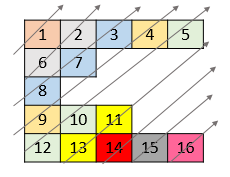There is a room with n bulbs, numbered from 0 to n-1, arranged in a row from left to right. Initially all the bulbs are turned off.
Your task is to obtain the configuration represented by target where target[i] is ‘1’ if the i-th bulb is turned on and is ‘0’ if it is turned off.
You have a switch to flip the state of the bulb, a flip operation is defined as follows:
- Choose any bulb (index
i) of your current configuration. - Flip each bulb from index
iton-1.
When any bulb is flipped it means that if it is 0 it changes to 1 and if it is 1 it changes to 0.
Return the minimum number of flips required to form target.
Example 1:
Input: target = "10111" Output: 3 Explanation: Initial configuration "00000". flip from the third bulb: "00000" -> "00111" flip from the first bulb: "00111" -> "11000" flip from the second bulb: "11000" -> "10111" We need at least 3 flip operations to form target.
Example 2:
Input: target = "101" Output: 3 Explanation: "000" -> "111" -> "100" -> "101".
Example 3:
Input: target = "00000" Output: 0
Example 4:
Input: target = "001011101" Output: 5
Constraints:
1 <= target.length <= 10^5target[i] == '0'ortarget[i] == '1'
给一排灯泡,初始时都是灭的,每次可以选第i个灯泡,然后把第i个到最后的所有灯泡的状态翻转。问最少需要多少次操作才能得到目标状态序列。
很有意思的题,观察数据发现数据规模在1e5,数据量比较大,估计只有O(n)算法能过。接着,观察样例,不要被样例的解答给迷惑了。比如第一个例子10111,除了样例的解法,还可以谈心的做,序列变化如下:
0. 00000
1. 11111
2. 10000
3. 10111
即每次从左往右,把第一个不符合target状态的灯及往后的灯都flip,这种方法已经是最优的了。所以对于任意一个灯泡,它至少被翻转的次数就是它前面有多少种连续不同状态的灯泡。比如对于10111的后三个111,它前面有1和0,因为最原始是00,要变成10,则在满足第一个灯泡时有个0->1的翻转,导致第2个灯泡也变了;第二个灯泡也要flip一次;等到111时,它需要翻转的次数就是前面10共有2种特异状态。
所以问题转换为求字符串中有多少个连续相同状态的片段,所有片段数就是需要翻转的次数。另外要注意如果开头是0的话,则开头可以少翻转一次。代码如下:
class Solution {
public:
int minFlips(string target) {
int n = target.size();
int ans = 0;
int i = 0;
while (i < n) {
int j = i + 1;
while (j < n&&target[j] == target[i])++j;
++ans;
i = j;
}
if (target[0] == '0')return ans - 1;
else return ans;
}
};本代码提交AC。


